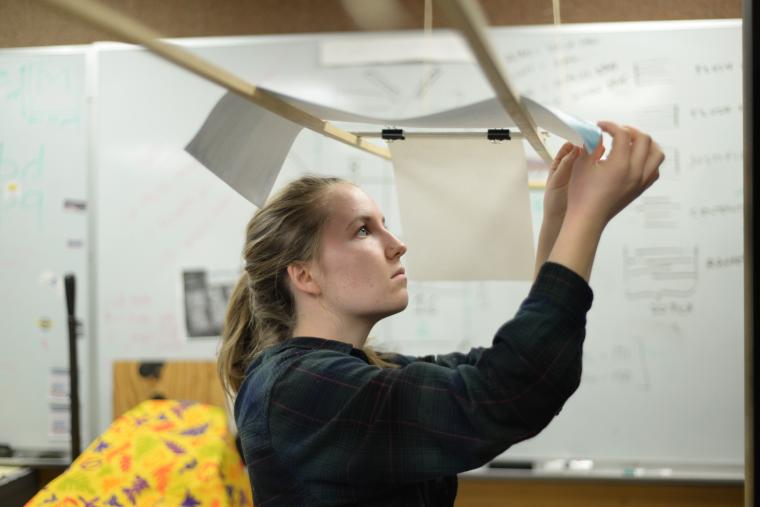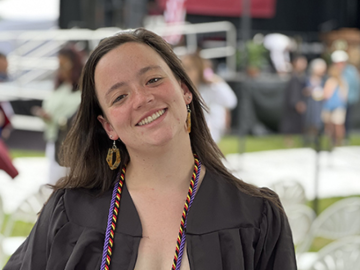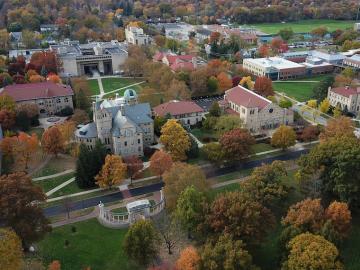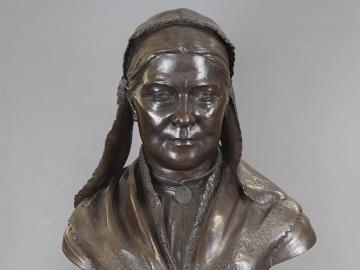Learning through the Letterpress
April 15, 2015
Madeline Raynor

One of the best resources for hands-on learning at Oberlin hides in plain sight behind large glass windows on the second floor of Mudd Center library. This is the Letterpress Studio, containing three manual printing presses surrounded by cabinets of moveable type. Special Collections and Preservation Librarian Ed Vermue presides over the studio, which is accessible to students through an Experimental College (ExCo) class, a winter-term group project, and opportunities for class visits.
The Letterpress Studio was organized in 2010. “It was a long time coming,” Vermue explains. Faculty members had been interested in teaching the history of the book through hands-on experience with a printing press for a while, but the idea finally fell into place after a series of fortuitous donations were made. Cabinets of type and bookworking tools came from husband and wife Dewey and Carol Ganzel, an English professor at Oberlin and journalist, respectively. Two small hand presses, along with more type and tools, came from the family of Gus Brunsman II, which ran Trailside Press in Kettering, Ohio. Finally, with help from the English department, Vermue bought a vintage Vandercook press, the largest press in the studio.
Using the three presses, students in the ExCo and winter-term class learn how to set type, ink up a press, and print the way it was done from Johannes Gutenberg up until the computer. Letterpress printing is a time-consuming process: Each letter has to be set individually, and the type must be set backwards for the final product to appear correctly.
The winter-term class is intensive: Students spend full days in the studio working on a book commission with a deadline, which, in the past, has been anything from printing poetry from alumni authors to creating broadsides of poems from Oberlin College Press. “The idea is to introduce a little bit of stress to the experience,” Vermue says. “They’re actually working the way printers used to work. ”
While students participating during winter term are required to work together on one large project, students in the ExCo have the opportunity to work individually and pursue their own interests. Senior studio art major Sarah Lejeune, who took the ExCo in 2013, now works as an assistant in the Letterpress Studio. Lejeune’s art focuses on nostalgia and exploring the ephemeral nature of memory and experience. She is drawn to letterpress printing for its long history. “It is deeply tied to the passing on of information,” she says. “I really like letterpress as a process because of how intricate [and how much of a] technical skill it is.”
Many professors say they are also eager to take advantage of the letterpress as a learning tool for their classes. Assistant Professor of English Laura Baudot brings her Eighteenth-Century British Novel and Print Culture class to the Letterpress Studio to help students to think about how books were made before mechanical printing. “There are a lot of eighteenth-century authors, such as [Laurence] Sterne, who were hyperconscious of the status of the book, both as a commodity and a possible artistic media. They wanted to draw your attention to the physical appearance of the book,” Baudot explains. While reading Sterne’s Tristam Shandy, which famously features a unique marbled page in volume three of every original edition, students learn how to make marbled paper and view one of the original marble pages during a visit to special collections.
According to Vermue, the point of modern letterpress printing is not to turn back the clock but to have a point of reference for how printing was executed for hundreds of years. Without a computer to do everything for you, you need to think about each decision in the printing process, such as spacing, typeface, and illustrations. Letterpress printing is a framework and a tool that can help students better understand the literature of the past and create art in the present. “Nobody hates computers, but some are glad to be away from them for a little bit,” Vermue says. “Students are nostalgic for doing things with their hands.”
Tags:
You may also like…
Full Immersion
June 15, 2023
Dewi Beer’s love of teaching and language converge in a Taiwanese fellowship.
Oberlin College Receives National Endowment for the Arts Big Read Grant
August 17, 2022
Oberlin College is one of 62 organizations nationwide selected to receive a 2022-2023 NEA Big Read grant. A grant of $9,400 will support a community reading program focusing on Homegoing by Yaa Gyasi.
Art in the Archives: Works Presented for the First Time
February 1, 2021
A new virtual exhibit by the Oberlin College Archives showcases artworks with deep institutional history.


